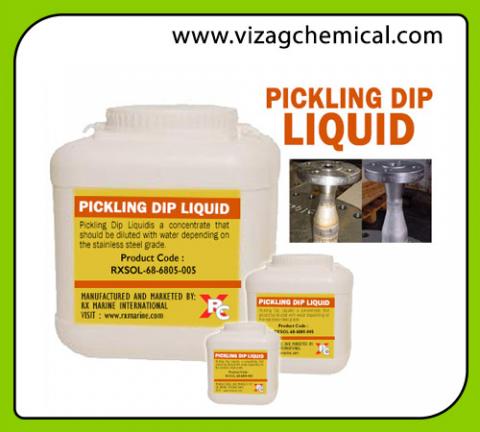Primary tabs

Pickling Dip Liquid
RXSOL Pickling Liquid - Performs multiple cleaning action such as degreaser by removing oil effectively and also providing protective coating to keep rust free surface. Uses of Pickling liquid RXSOL helps to keep metal surface as priming after welding which can be used for Electrostatic Painting and powder coating. Also Uses of Pickling Liquid RXSOL helps to eliminate uses of all hazardous chemicals such as solvent, Acid, Phophate, Chromate etc. And its uses also helps to avoid sand scrubbing, blassting for metal surface preparation.
The Pickling Dip Liquid fluid is recommended for immersion pickling of small objects and for pickling surfaces that are time-consuming to brush or spray pickle. It can also be used for circulation pickling of pipe systems. Pickling Liquid reduced the Re-work to Zero, saving a lot of labor, time & cost.
Standard grades, such as 304 and 316: Mix 1 part Pickling Dip Liquid into 3 patrs of water. A further dilution can be done if longer pickling timesc an be accepted. High-alloyed grades, such as duplex grades (2205) and austenitic grades (904 L) for use in severe corrosive conditions: Mix 1 part of Pickling Dip Liquid in to 2 parts of water. Very high alloyed grades, such as super-austenitic (254 SMO) and super-duplex (2507) grades: Mix 1 part of Pickling Dip Liquid into 1 part of water.
1. Before first time use. Make the solution by adding the Pickling Dip Liquid to the water, not the other way round! The proportions depend on the steel to be pickled.
2. Pre-clean the objects to remove grease and oil before pickling by using RXSOL DEGREASER.
3. Place the product in the pickling bath.
4. Allow sufficient pickling time. Use 5 min to 4 hours depending on temperature, steel grade, condition of the Pickling Dip Liquid etc.
5. Rinse with high-pressure water jet after pickling.
6. Analyse the Pickling Dip Liquid content of acids and free metals regularly to maintain optimal Pickling Dip Liquid composition.
Using Procedure
| Stainless Steel Grade | Examples | Dilution Ratio (Pickling Dip Liquid : Water) | Notes |
|---|---|---|---|
| Standard Grades | 304, 316 | 1 : 3 | Can be further diluted if longer pickling time is acceptable |
| High-Alloyed Grades | Duplex (2205), Austenitic (904L) | 1 : 2 | Suitable for severe corrosive conditions |
| Very High Alloyed Grades | Super-Austenitic (254 SMO), Super-Duplex (2507) | 1 : 1 | For extremely demanding corrosive environments |
Features & Benefit :
-
Restores stainless steel surfaces that have been damaged during fabrication operations such as welding, forming, cutting and blasting. It removes weld oxides, the underlying chromium-depleted layer and other defects that may cause local corrosion.
- Working life; the bath fluid is consumed during usage and the effective working life of the bath fluid is determined by the amount of acids and dissolved metals. The bath fluid should hence be analysed regularly, and new acid should be added when needed in order to obtain an optimal pickling result. Avesta Finishing Chemicals may assist with this analysis service.
Storage:
Pickling Dip Liquid should be stored indoors at room temperature. Containers must be kept properly closed, in an upright position and inaccessible to unauthorised persons. The products are perishable and should not be kept in storage longer than necessary. They have a maximum shelf life of two years when stored at room temperature. Exposure to higher temperatures may reduce shelf life
Handling :
Protective clothing. In general users should wear acid-resistant overalls, gloves and rubber boots. Face visor should be used and, if necessary, suitable respiratory protective devices. Special conditions may apply from one country to another. Refer our Material Safety Data Sheets.
|
Physical state at 20oC |
: |
Colourless liquid |
|
Boiling point |
: |
80-100oC |
|
Flash point / Explosion properties |
: |
Not applicable |
|
Specific temperatures: |
: |
Solid-fluid 40oC, Fluid-gas 50-60oC (nitric fumes) |
|
Vapour pressure at 20oC |
: |
< 0.01 kPa |
|
pH |
: |
0 at 20oC |
|
Density |
: |
1.1-1.4 g/cm3 at 20oC |
|
Solubility in water at 20oC |
: |
100 weight % |
MATERIALS AND CONDITIONS TO AVOID INCOMPATIBILITY : Caustics, Amines, Alkanolamines, Aldehydes, strong Oxidizing agents and Chlorinated compounds.
